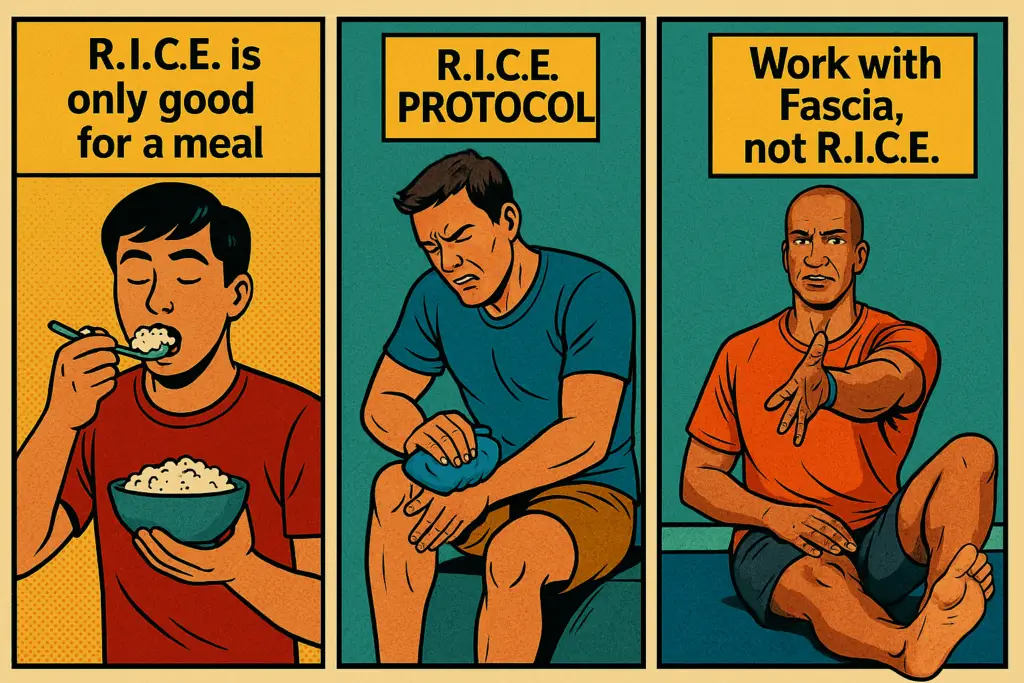
❄️ Why R.I.C.E. Isn’t the Best Way to Heal
Most of us grew up hearing the same advice when we got hurt:
Rest. Ice. Compress. Elevate.
This is called the R.I.C.E. method—and while it once seemed smart, even Dr. Gabe Mirkin, who coined the term in 1978, has since retracted it. In his article “Why Ice Delays Recovery,” Dr. Mirkin explains that excessive icing can hinder the body’s natural healing process.
Why? Because fascia healing doesn’t happen by stopping the body. It happens through flow.
💡 What’s Wrong With Icing Too Much?
Ice helps right after an injury—for the first 12 to 24 hours.
It slows swelling and bruising, and that’s useful.
But after that? ❌
Too much ice can block the very process your body needs to heal.
It slows blood flow, pushes out the helpful cells, and delays your recovery.
🔬 Fascia Healing Happens in 3 Natural Phases
Let’s break it down simply. When you get hurt or sick, your body starts healing in three steps:
1️⃣ Vascular Phase(2 parts): First Comes the Swelling
When you get hurt, your body quickly sends more blood to the area.
This is called vasodilation, and it’s the first part of the healing process.
All that blood brings oxygen, nutrients, and important “emergency signals” that call for help.
🧊 This is the short window where ice can help.
If there’s a lot of swelling or bruising, icing during the first 12 to 24 hours can slow it down and protect nearby tissues.
But then the second part kicks in…
Now, tiny blood vessels open up and allow special immune helpers to pass through.
These cells begin preparing the area for repair. This part needs flow, not freezing.
So ice is only useful in the very beginning.
After that, movement, hydration, and gentle pressure help your body do its job.
2️⃣ Cellular Phase: The Cleanup Crew Arrives
Next, special immune cells move in.
They clean up the mess, fight off problems, and prepare your body for repair.But if you keep icing?
It’s like putting a roadblock in front of those helpful cells.
3️⃣ Repair Phase: Tissue Starts to Rebuild
Once your body starts to rebuild, the goal isn’t to stay still—it’s to support the process.
Your fascia, muscles, and joints need:
- Movement to keep fluids flowing
- Breath to improve circulation
- Light pressure to guide repair without overload
These things don’t just “speed up” healing—
They help your body do what it already knows how to do.

At SolCore Fitness we don’t fight the body’s response. We work with it—through guided movement and hands on treatment with methods like ELDOA, myofascial stretching, fascia-based exercise and fascial pumping to help your body heal with its natural rhythm.
These are the tools that work with your fascia, not against it.
This is where fascia healing really begins.
New tissue is built. Fluid clears. Your body restores balance.
But here’s the key:
✅ This only happens if there’s movement, hydration, and gentle pressure.
🧘♂️ What Helps Fascia Heal Best?
- Short-term ice (only in the first 12–24 hours)
- After that:
- Breathing
- Gentle movement
- Techniques like pumping and stretching
At SolCore Fitness, we use methods like ELDOA, myofascial stretching, and fascial pumping to help your body heal with its natural rhythm.
These are the tools that work with your fascia, not against it.
🚫 Don’t Freeze the Flow. Support It.
Your fascia isn’t just a tissue—it’s a system.
It thrives on movement, hydration, and flow.The R.I.C.E. method stops that flow.
But fascia healing needs it to recover.✅ What You Can Do Today
- Got an old injury that won’t heal?
- Or a new one you’re icing too long?
Try fascia-first movement instead.
Give your body what it’s really asking for: flow, not freezing.💆♂️ Want to Learn How to Take Better Care of Your Fascia?
If you want to move better, feel stronger, and truly support your body’s natural healing…
Discover the power of Osteopathic Manual Therapy.
It’s one of the most effective ways to restore balance, reduce pain, and help your fascia heal the way it was designed to.
Follow the Thread—Where Movement, Fascia, and Freedom Align
Find more insight, reflection, and fascia-informed care across the platforms where we stay connected:

Leave a Reply